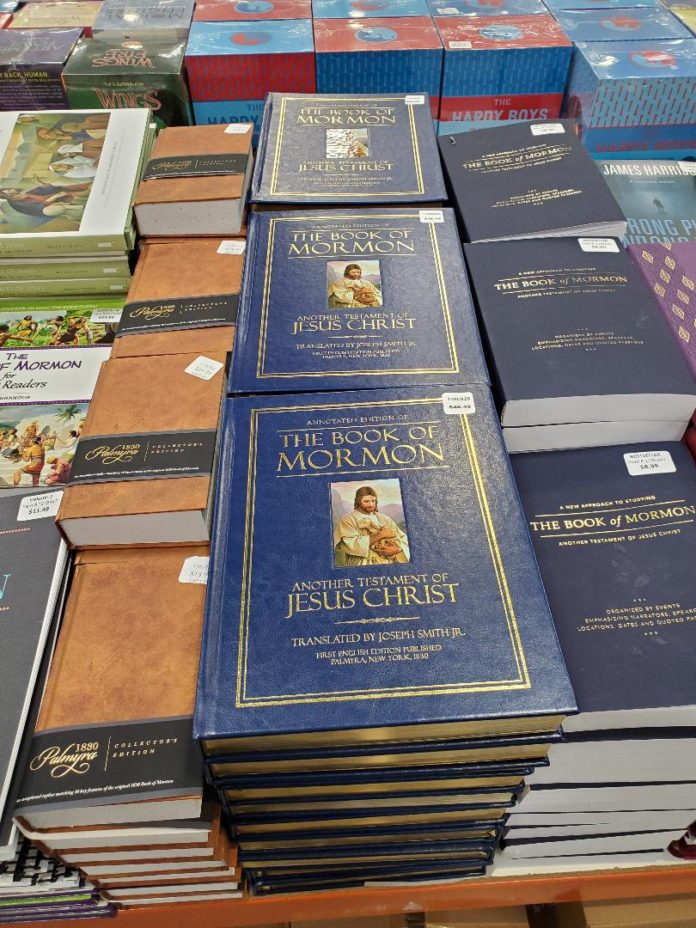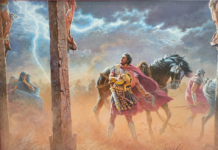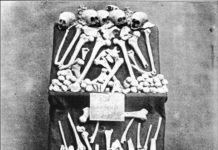

I wanted to give you an update on the New Annotated Edition of the Book of Mormon. As you may remember we printed our first 5,000 copies in Sept 2018. Those were gone in less than one month. We then had another 10,000 printed and available for last Christmas 2018. Those are now almost all sold. We now have another 10,000 ready to arrive any week now. Thanks to each of you, and your friends for supporting this amazing new edition of the Book of Mormon. This will mean that we have printed 25,000 within about one year. That is remarkable and we feel grateful that so many wonderful people are reading the Book of Mormon.
Now with Christmas coming and the new Sunday School curriculum being the Book of Mormon, what another great time to stock up on a few more of these wonderful gifts.
We are happy to let you know that 17 Costco Stores from Idaho, Utah and Arizona now have them in stock. Here are the stores: Boise, Idaho; Idaho Falls, Gilbert, AZ; Murray, UT; South Ogden, UT; Lehi, UT; St. George, UT; Spanish Fork, UT; Bountiful, UT; Salt Lake City, UT; Mesa, AZ; Orem, UT; Pocatello, ID; South Jordan, UT; Twin Falls, ID; West Valley, UT; Sandy, UT;

Now Available at Deseret Book!
THIS NEW EDITION FEATURES – FOR THE FIRST TIME EVER
-The words of the Lord in red
-Scripture quoted by the Lord in red italic
-Angel’s words in blue
-Quoted scripture in blue italic
-Paragraphs forming complete thoughts
-Multiple in-line topic headings per chapter
-Poetry format showing Hebrew expressions
-Chiastic structures outlined
-Bold text identifying writers (I, Nephi)
-Dozens of original art pieces
-Over 600 pages with the most up-to date historical, archaeological, linguistic, genetic, chronological and doctrinal insights
-Engaging study aids
-Over 250 “insights” pages of in-depth information.
-More than 500 photos, illustrations, charts, graphs, maps, timelines, chronologies, notations and historical references together with hundreds of prophetic quotes.
-Deluxe large format full color book comes in navy blue
-Leatherette hardcover with gold gilding and embossing,
-Smyth-sewn binding, and two ribbon bookmarks.
The Book of Mormon is an account of the “former inhabitants of this continent” that contains “the fulness of the everlasting gospel….as delivered by the Savior to the ancient inhabitants,” (Joseph Smith-History, 1:34) who were the “other sheep” Jesus spoke of during His ministry in Jerusalem.

The Annotated Book of Mormon has been created to help readers understand the everlasting gospel as explained in the text, together with what the modern prophets and apostles have taught about it. The text has been formatted so readers can identify natural conversations, poetic speech patterns, prophecies, and the words of God.The annotations include prophetic commentaries on quoted scripture and the use of colored text. (See “A Text Formatting Guide,” pp. xxv and xxvi). These elements bear witness to the divinity of this ancient text by drawing upon Hebrew tradition—much different from the nineteenth century rural America known to Joseph Smith.
The Annotated Book of Mormon also focuses on an important part of Moroni’s introduction; i.e., the “former inhabitants of this continent.” Joseph Smith, writing in Nauvoo, Illinois, in 1842, explained that “the remnant [of these ancient inhabitants] are the Indians that now inhabit this country.” (See Appendix, “Church History—Wentworth Letter,” pp. 546-549.) Oliver Cowdery mentioned this in his Letter VII (see p. 515).
There are “insight pages” inserted throughout the text. These include illustrations, images, maps and prophetic statements that support the proposition that the ancestors of the “Indians that now inhabit this country” closely fit the time frames and events described in the Book of Mormon. As such, their identity is an additional witness of the divine authenticity of the text.

The “insight pages” are provided to enhance understanding of the text as an authentic history of the ancestors of the Indians who live in this country, not to establish a specific geography. It is recognized that, apart from the New York Cumorah, Church leaders have declined to correlate Book of Mormon sites with modern locations. It is left to individuals to do their own research and reach their own conclusions. In 1929, Anthony W. Ivins, counselor in the First Presidency, added, ‘There has never been anything yet set forth that definitely settles that question [of overall Book of Mormon geography]…We are just waiting until we discover the truth’ – Conference Report [April 1929], 16.
Regarding Cumorah, however, Church leaders have consistently taught the New York setting. President Cowdery’s Letter VII unambiguously declared that the New York hill was (i) the location of Moroni’s stone box from which Joseph obtained the plates; (ii) the scene of the final battles of the Nephites and Jaredites; and (iii) the site of Mormon’s depository of Nephite records (Mormon 6:6). Joseph Smith had Letter VII copied into his personal history as part of his life story. Letter VII was re-published in early Church publications including the Times and Seasons, the Gospel Reflector, the Millennial Star, the Prophet, and the Improvement Era. Prophets and apostles have reaffirmed this teaching, including Brigham Young, Wilford Woodruff, Heber C. Kimball, Joseph F. Smith, Joseph Fielding Smith, Anthony W. Ivins, James E. Talmage, LeGrand Richards, Marion G. Romney, and Mark E. Petersen.
Pursuant to the acquisition of the Hill Cumorah in Manchester, New York in 1928, President Anthony Ivins declared in General Conference, “It was here that two once-powerful nations were exterminated so far as their national existence was concerned. It was here that these nations gathered together for the last great struggles…all of the sacred records of the Nephite people, were deposited by Mormon in that hill.” (Improvement Era [June 1928]; see also “Celebration of the Purchase of the Hill Cumorah,” p. 440.
Beyond Cumorah, there have been a few other statements by Joseph Smith, Jr. and his contemporaries that readers may find interesting and useful. Incorporated in this Annotated Edition are maps that depict specific locations given through revelation, in journal entries, or in an official Church publication. These maps help explain how the Book of Mormon is a history of the ancestors of the Indians who live in this country, but they are not to be considered official Church doctrine.
—————————–FOOTNOTE——————————————————-
*Letter IV is the one of eight letters written by Oliver Cowdery under the direction of Joseph Smith, Jr. The letters were written in response to the first anti-Mormon publication “Mormonism Unvailed” in the fall of 1834, which claimed that the Book of Mormon was fiction, plagiarized from other then-extant publications. These eight letters are significant to Latter-day Saints because parts of them have been canonized in the Pearl of Greet Price, other parts are quoted widely in historical research and excerpted into many Church publications and Conference talks. All eight letters were republished on multiple occasions and distributed widely during the first 100 years of the Church’s development. Letter VII is particularly significant because it provides the greatest amount of detail regarding the Hill Cumorah (see Mormon 6:2-6; pp. 438-439) that has ever been documented by the First Presidency in this dispensation. For more about these important letters turn to pp. 491, 512-16 and 522.
INTRODUCTION TO FORMATTING STYLE ELEMENTS
THE ANNOTATED EDITION OF THE BOOK OF MORMON has been formatted to enlarge our understanding of and give reverence to this unique and sacred volume of scripture. The reader will immediately note that the text is structured and formatted differently from the versions currently in print.
THE ANNOTATION OF THE TEXT utilizes several style elements:
▪ Use of quotations when there is speech
▪ Use of paragraphs for complete thoughts
▪ Use of color for clarity of voice spoken: Red for Deity; Blue for angels; Blue for quoted scripture
▪ Use of capitalized references to Deity, i.e. Thee, Thou, Thine, Me, Mine, Spirit, etc.
▪ Use of style elements for emphasis, i.e. prophecies are indented with a smaller type font
▪ Use of capitalized nouns (i.e. Plates of Brass, Valley of Lemuel, House of Israel, etc.)
▪ Use of bold text for I, Nephi; I, Lehi; I, Jacob; I, Mormon, etc. to highlight personal records
▪ Use of italics for paraphrased quotes; the voice of the Master (Lord of the vineyard) in Jacob 5
 John H. Gilbert typeset the original 1830 edition for the publisher, Mr. Egbert B. Grandin, printer of the Wayne Sentinel. His recollections of the events are instructive: “After working a few days, I said to [Hyrum] Smith on his handing me the manuscript in the morning, ‘Mr. [Hyrum] Smith, if you would leave this manuscript with me, I would take it home with me at night and read and punctuate it, and I could get along faster in the daytime, for now I have frequently to stop and read half a page to find how to punctuate it.’ [For an example see Background, p. xxvi.] His reply was, ‘We are commanded not to leave it.’ A few mornings after this, when [Hyrum] Smith handed me the manuscript, he said to me, ‘If you will give your word that this manuscript shall be returned to us when you get through with it, I will leave it with you.’ I assured Smith that it should be returned all right when I got through with it. For two or three nights I took it home with me and read it, and punctuated it with a lead pencil. This will account for the punctuation marks in pencil, which is referred to in the Mormon Report, an extract from which will be found below. “Names of persons and places were generally capitalized, but sentences had no end. The character or short ‘&’ was used almost invariably where the word ‘and’ occurred, except at the end of a chapter. I punctuated it to make it read as I supposed the author intended, and but very little punctuation was altered in proofreading. The Bible [Book of Mormon] was printed sixteen pages at a time, so that one sheet of paper made two copies of sixteen pages each, requiring 2,000 sheets of paper for each form of sixteen pages. There were thirty-seven forms of sixteen pages each—570 pages in all.” – Recollections of John H. Gilbert [Regarding printing the Book of Mormon], 8 September 1892, Palmyra, New York, typescript, Harold B. Lee Library, Brigham Young University, Provo, UT (http://www.boap.org/LDS/Early Saints/JHGilbert.html). Over the years, changes in how The Book of Mormon has been formatted have resulted in several editions being published. Currently, The Book of Mormon has been divided into chapters and verses, and many key words have been marked for cross-referencing, with the original punctuation marks inserted by Mr. Gilbert left largely unchanged throughout the varied publications.
John H. Gilbert typeset the original 1830 edition for the publisher, Mr. Egbert B. Grandin, printer of the Wayne Sentinel. His recollections of the events are instructive: “After working a few days, I said to [Hyrum] Smith on his handing me the manuscript in the morning, ‘Mr. [Hyrum] Smith, if you would leave this manuscript with me, I would take it home with me at night and read and punctuate it, and I could get along faster in the daytime, for now I have frequently to stop and read half a page to find how to punctuate it.’ [For an example see Background, p. xxvi.] His reply was, ‘We are commanded not to leave it.’ A few mornings after this, when [Hyrum] Smith handed me the manuscript, he said to me, ‘If you will give your word that this manuscript shall be returned to us when you get through with it, I will leave it with you.’ I assured Smith that it should be returned all right when I got through with it. For two or three nights I took it home with me and read it, and punctuated it with a lead pencil. This will account for the punctuation marks in pencil, which is referred to in the Mormon Report, an extract from which will be found below. “Names of persons and places were generally capitalized, but sentences had no end. The character or short ‘&’ was used almost invariably where the word ‘and’ occurred, except at the end of a chapter. I punctuated it to make it read as I supposed the author intended, and but very little punctuation was altered in proofreading. The Bible [Book of Mormon] was printed sixteen pages at a time, so that one sheet of paper made two copies of sixteen pages each, requiring 2,000 sheets of paper for each form of sixteen pages. There were thirty-seven forms of sixteen pages each—570 pages in all.” – Recollections of John H. Gilbert [Regarding printing the Book of Mormon], 8 September 1892, Palmyra, New York, typescript, Harold B. Lee Library, Brigham Young University, Provo, UT (http://www.boap.org/LDS/Early Saints/JHGilbert.html). Over the years, changes in how The Book of Mormon has been formatted have resulted in several editions being published. Currently, The Book of Mormon has been divided into chapters and verses, and many key words have been marked for cross-referencing, with the original punctuation marks inserted by Mr. Gilbert left largely unchanged throughout the varied publications.

The editors wish to thank the many who contributed to this publication, through their own attentive research, uniquely individual talents and personal dedication to their craft. In particular, we express appreciation to the scholars, students of the scriptures, artists, photographers and proofreaders who have generously shared their gifts and talents in providing timely, relevant content, critical feedback and constructive criticism—for these contributions we are most grateful. Finally, we thank our spouses, our families and our colleagues, whose intimate support has enabled this work to fill the measure of its creation. – David R. Hocking, Rodney L. Meldrum, Editors
“And we talk of Christ,
we rejoice in Christ,
we preach of Christ,
we prophesy of Christ,
and we write according to our prophecies,
that our children may know to what source
they may look for a remission of their sins.”
(2 Nephi 25:26)










